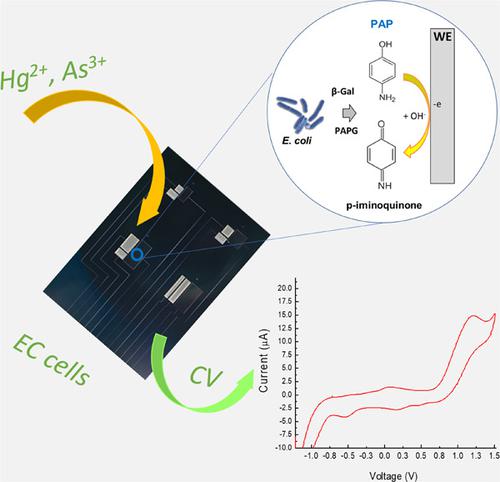当前位置:
X-MOL 学术
›
Biotechnol. Bioeng.
›
论文详情
Our official English website, www.x-mol.net, welcomes your
feedback! (Note: you will need to create a separate account there.)
Miniaturized electrochemical biosensor based on whole‐cell for heavy metal ions detection in water
Biotechnology and Bioengineering ( IF 3.5 ) Pub Date : 2020-12-07 , DOI: 10.1002/bit.27646 Emanuele L Sciuto 1 , Salvatore Petralia 2, 3 , Jan R van der Meer 4 , Sabrina Conoci 3, 5
Biotechnology and Bioengineering ( IF 3.5 ) Pub Date : 2020-12-07 , DOI: 10.1002/bit.27646 Emanuele L Sciuto 1 , Salvatore Petralia 2, 3 , Jan R van der Meer 4 , Sabrina Conoci 3, 5
Affiliation

|
The heavy metals pollution represents one of the important issues in the environmental field since it is involved in many pathologies from cancer, neurodegenerative, and metabolic diseases. We propose an innovative portable biosensor for the determination of traces of trivalent arsenic (As(III)) and bivalent mercury (Hg(II)) in water. The system implements a strategy combining two advanced sensing modules consisting in (a) a whole cell based on engineered Escherichia coli as selective sensing element towards the metals and (b) an electrochemical miniaturised silicon device with three microelectrodes and a portable reading system. The sensing mechanism relies on the selective recognition from the bacterium of given metals producing the 4‐aminophenol redox active mediator detected through a cyclic voltammetry analysis. The miniaturized biosensor is able to operate a portable, robust, and high‐sensitivity detection of As(III) with a sensitivity of 0.122 µA ppb−1, LoD of 1.5 ppb, and a LoQ of 5 ppb. The LoD value is one order of magnitude below of the value indicated to WHO to be dangerous (10 μg/L). The system was proved to be fully versatile being effective in the detection of Hg(II) as well. A first study on Hg(II) showed sensitivity value of 2.11 µA/ppb a LOD value of 0.1 ppb and LoQ value of 0.34 ppb. Also in this case, the detected LOD was 10 times lower than that indicated by WHO (1 ppb). These results pave the way for advanced sensing strategies suitable for the environmental monitoring and the public safety.
中文翻译:

基于全细胞的微型电化学生物传感器用于水中重金属离子检测
重金属污染是环境领域的重要问题之一,因为它涉及癌症、神经退行性和代谢疾病的许多病理。我们提出了一种创新的便携式生物传感器,用于测定水中痕量的三价砷 (As(III)) 和二价汞 (Hg(II))。该系统实施了一种策略,结合了两个先进的传感模块,包括 (a) 基于工程大肠杆菌的全细胞作为对金属的选择性传感元件和(b)具有三个微电极和便携式读取系统的电化学微型硅装置。传感机制依赖于细菌对给定金属的选择性识别,通过循环伏安法分析检测到产生 4-氨基苯酚氧化还原活性介质。小型化生物传感器能够以 0.122 µA ppb -1的灵敏度对 As(III) 进行便携式、稳健且高灵敏度的检测,LoD 为 1.5 ppb,LoQ 为 5 ppb。LoD 值比 WHO 指示的危险值 (10 μg/L) 低一个数量级。该系统被证明是完全通用的,在检测 Hg(II) 方面也是有效的。对 Hg(II) 的第一项研究显示灵敏度值为 2.11 µA/ppb,LOD 值为 0.1 ppb,LoQ 值为 0.34 ppb。同样在这种情况下,检测到的 LOD 比 WHO 指示的 LOD (1 ppb) 低 10 倍。这些结果为适用于环境监测和公共安全的先进传感策略铺平了道路。
更新日期:2020-12-07
中文翻译:

基于全细胞的微型电化学生物传感器用于水中重金属离子检测
重金属污染是环境领域的重要问题之一,因为它涉及癌症、神经退行性和代谢疾病的许多病理。我们提出了一种创新的便携式生物传感器,用于测定水中痕量的三价砷 (As(III)) 和二价汞 (Hg(II))。该系统实施了一种策略,结合了两个先进的传感模块,包括 (a) 基于工程大肠杆菌的全细胞作为对金属的选择性传感元件和(b)具有三个微电极和便携式读取系统的电化学微型硅装置。传感机制依赖于细菌对给定金属的选择性识别,通过循环伏安法分析检测到产生 4-氨基苯酚氧化还原活性介质。小型化生物传感器能够以 0.122 µA ppb -1的灵敏度对 As(III) 进行便携式、稳健且高灵敏度的检测,LoD 为 1.5 ppb,LoQ 为 5 ppb。LoD 值比 WHO 指示的危险值 (10 μg/L) 低一个数量级。该系统被证明是完全通用的,在检测 Hg(II) 方面也是有效的。对 Hg(II) 的第一项研究显示灵敏度值为 2.11 µA/ppb,LOD 值为 0.1 ppb,LoQ 值为 0.34 ppb。同样在这种情况下,检测到的 LOD 比 WHO 指示的 LOD (1 ppb) 低 10 倍。这些结果为适用于环境监测和公共安全的先进传感策略铺平了道路。











































 京公网安备 11010802027423号
京公网安备 11010802027423号